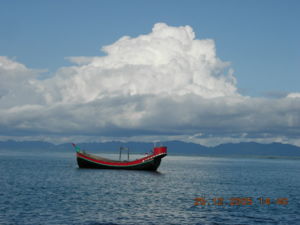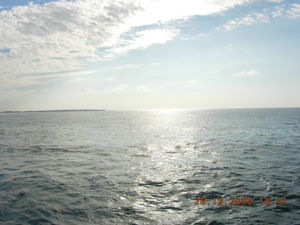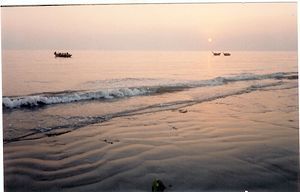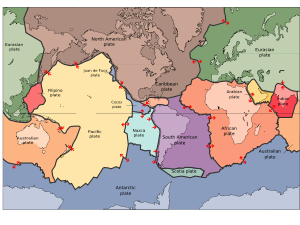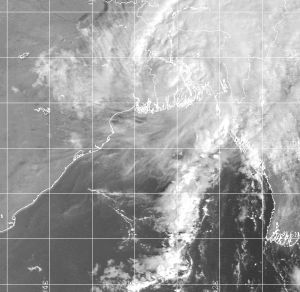Bay of Bengal
2008/9 Schools Wikipedia Selection. Related subjects: Geography
| Bay of Bengal, Indian Ocean | |
|---|---|
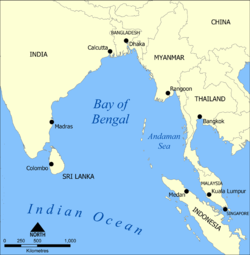 |
|
| Profile: Facts and Figures at a Glance | |
| Area | 2,172,000 km² |
| Average depth: | 2,600 mm ; 8,500 feet |
| Maximum depth: | 4,694 m ; 15,400 feet |
| Maximum Length: | 2,090 km; c.1,300 mi |
| Maximum Width: | 1,610 km; 1,000 mi |
| Waters Connected to the Bay of Bengal: |
|
| Rivers which drain into Bay of Bengal: |
|
| Important Ports: |
|
| Historic Ports: |
|
| Islands: |
|
| Coasts: |
|
| Battles: |
|
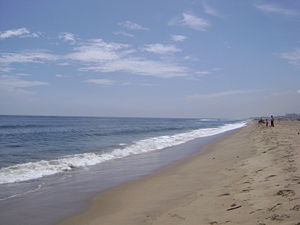
The Bay of Bengal is a bay that forms the northeastern part of the Indian Ocean. It resembles a triangle in shape, and is bordered by India and Sri Lanka to the West, Bangladesh and the Indian state of West Bengal to the North (where the name comes from), and Myanmar, southern part of Thailand and the Andaman and Nicobar Islands to the East. Its southern boundary extends as an imaginary line from Dondra Head at the southern end of Sri Lanka to the northern tip of Sumatra.
The Bay of Bengal occupies an area of 2,172,000 km². A number of large rivers – Ganges, Brahmaputra, Ayeyarwady, Godavari, Mahanadi, Krishna and Kaveri – flow into the Bay of Bengal. Among the important ports are Cuddalore, Chennai, Kakinada, Machilipatnam, Vishakapatnam, Paradip, Kolkata, Chittagong, and Yangon.
Etymology
In the 10th century conflicts caused the Bay of Bengal to be called "The Chola Lake." Bangal ki Khadi is the name in Hindi.
Bengal comes from the Sanskrit Banga or Vanga and refers to the Gangetic delta waters. There is mythology which relates the area given to the Lunar race of Delhi.
Rivers
Many major rivers of India flow west to east into the Bay of Bengal: in the north, the Ganges River (or Ganga), Meghna River and Brahmaputra River rivers, and in the south Mahanadi River through the Mahanadi River Delta, Godavari River, Krishna River, Irrawaddy and Kaveri River (sometimes written as Cauvery) rivers. The shortest classified river which drains into the Bay of Bengal is Cooum River at 64 km. Brahmaputra is the 28th longest River in the World (2,948 km or 1,832 mi), and it discharges into the 'Bay of Bengal' and travels through India, P.R. China, Nepal, Bangladesh and Bhutan. The Sundarbans mangrove forest is formed at the delta of the Ganga, Brahmaputra and Meghna rivers on the Bay of Bengal. The Ayeyarwady River of Myanmar also flows into the bay.
Seaports
Major Bangladeshi ports on the bay include Chittagong and Mongla. Major Indian ports on the bay include Chennai (formerly Madras), Vishakhapatnam, Kolkata (formerly Calcutta), and Pondicherry. Yangon, the largest city and former capital of Myanmar is also an important port in the bay.
Islands
The islands in the bay are very numerous, including the Andaman, Nicobar and Mergui groups. The group of islands, Cheduba and others, in the north-east, off the Burmese coast, are remarkable for a chain of mud volcanoes, which are occasionally active. Great Andaman is the main archipelago or island group of the Andaman Islands, whereas Ritchie's Archipelago consists of smaller islands. Only 37 of the 572 islands and islets of the Andaman and Nicobar Islands are inhabited, or 6.5%.
Beaches
Cox's Bazar, on the northeastern coast of the bay, is one of the longest unbroken natural beaches of the world. Other beaches along the bay are Bakkhali, Digha, Chandipur, Puri, Waltair, Marina Beach at Chennai and Ngapali beach in Myanmar.
Oceanography
Oceanography is the study of oceans and the ocean floor by scientific exploration and scientific methods. The Bay of Bengal is a salt water sea and is a part of the Indian Ocean.
Plate tectonics
The lithosphere of the earth is broken up into what are called tectonic plates. Underneath the Bay of Bengal is the Indian Plate which is part of the great Indo-Australian Plate and is slowly moving north east. This plate meets the Burma Microplate at the Sunda Trench. The Nicobar Islands, and the Andaman Islands are part of the Burma Microplate. The India Plate subducts beneath the Burma Plate at the Sunda Trench or Java Trench. Here, the pressure of the two plates on each other increase pressure and temperature resulting in the formation of volcanoes such as the volcanoes in Myanmar, and a volcanic arc called the Sunda Arc. Sumatra-Andaman earthquake and Asian Tsunami was a result of the pressure at this zone causing a submarine earthquake which then resulted in a huge Tsunamai.
Marine geology
A zone 50 m wide extending from the island of Ceylon and the Coromandel coast to the head of the bay, and thence southwards through a strip embracing the Andaman and Nicobar islands, is bounded by the ioo fathom line of sea bottom; some 50 m. beyond this lies the Soo-fathom limit. Opposite the mouth of the Ganges, however, the intervals between these depths are very much extended by deltaic influence.
Swatch of No Ground is a 14 km-wide deep sea canyon of the Bay of Bengal. The deepest recorded area of this valley is about 1340 m.
Marine biology, flora and fauna
The Bay of Bengal is full of biological diversity, diverging amongst coral reefs, estuaries, fish spawning and nursery areas, and mangroves. The Bay of Bengal is one of the World's 64 largest marine ecosystems.
Kerilia jerdonii is a sea snake of the Bay of Bengal. Glory of Bengal Cone (Conus bengalensis) is just one of the seashells which can be photographed along beaches of the Bay of Bengal.
An endangered species, the Olive Ridley sea turtle can survive because of the nesting grounds made available at the Gahirmatha Marine Wildlife Sanctuary, Gahirmatha Beach, Orissa, India.
Bryde's Whale which can be seen in the Bay of Bengal is the 10th heaviest animal of the world, weighing in at 22,000 kg (48,000 lb).
Marlin, barracuda, skipjack tuna, (Katsuwonus pelamis), yellowfin tuna, Indo-Pacific humpbacked dolphin (Sousa chinensis) , and Bryde's whale (Balaenoptera edeni) are a few of the marine animals. Bay of Bengal Hogfish (Bodianus neilli) is a type of Wrass which live in turbid lagoon reefs or shallow coastal reefs. Schools of dolphins can be seen, whether they are the bottle nose dolphin (Tursiops truncatus), Pantropical spotted dolphin (Stenella attenuata) or the spinner dolphin (stenella longirostris) . Tuna and dolphins are usually residing in the same waters. In shallower and warmer coastal waters the Irrawaddy Dolphins (Orcaella brevirostris) can be found.
The Great Nicobar Biosphere Reserve proides sanctuary to many animals some of which include the saltwater crocodile (Crocodylus porosus) , giant Leatherback Sea Turtle (Dermochelys coriacea) , and Malayan box turtle (Cuora amboinensis kamaroma) to name a few.
Another endangered species Royal Bengal Tiger is supported by Sundarbans a large estuarine delta that holds a mangrove area in the Ganges River Delta.
Coral beautifies the underwater area around Nicobar Islands, and the Andaman Islands
Chemical oceanography
Sri Lanka, Serendib, or Ratna – Dweepa which means Gem Island. Amethyst , beryl, rubies, sapphires, topazes, and garnet are just some of the gems of Sri Lanka.
Physical oceanography - Climate of the Bay of Bengal
From January to October, the current is northward flowing, and the clockwise circulation pattern is called the "East Indian Current." The Bay of Bengal monsoon moves in a northwest direction striking the Nicobar Islands, and the Andaman Islands first end of May, then the North Eastern Coast of India by end of June.
The remainder of the year, the counterclockwise current is southwestward flowing, and the circulation pattern is called the East Indian Winter Jet. September and December see very active weather, season varsha (or monsoon), in the Bay of Bengal producing severe Cyclones which affect Eastern India. Several efforts have been initiated to cope with Storm surge.
Tropical storms and cyclones
A tropical storm with rotating winds blowing at speeds of 74 miles (119 kilometers) an hour are called cyclones when they originate over the Bay of Bengal; they are hurricanes in the Atlantic. Between 100,000 and 500,000 residents of East Pakistan (Bangladesh) were killed because of the 1970 Bhola cyclone.
- 2008, Very Severe Cyclonic Storm Nargis
- 2007, Very Severe Cyclonic Storm Sidr
- 2006, Very Severe Cyclonic Storm Mala
- 2006, September Typhoon Xangsane
- 2004, November Typhoon Muifa
- 2002, May Tropical Cyclone 2B
- 1991, April Bangladesh cyclone
- 1989, November Typhoon Gay
- 1985, May Tropical Storm One (1B)
- 1982, April Cyclone One (1B)
- 1982, May Tropical Storm Two (2B)
- 1982, October Tropical Storm Three (3B)
- 1981, December Cyclone Three (3B)
- 1980, October Tropical Storm One (1B)
- 1980, December Unknown Storm Four (4B)
- 1980, December Tropical Storm Five (5B)
- 1971 Orissa Cyclone
- 1970, November Bhola cyclone
Historic sites
- Kumari Kandam, an antediluvian civilization, (South India) is also held in myth to be under the Bay of Bengal. Fisherman claim their nets have snagged, and on dives to free them they find pagodas, doorways, and temples to reinforce their belief of this ancient time.
- The remains of Sri Vaisakheswara Swamy temple lies under the Bay of Bengal. Spokespersons from Andhra University Centre for Marine Archaeology say the temple may be located opposite the Coastal Battery.
- Seven Pagodas of Mahabalipuram is the name for Mahabalipuram. Mahabalipuram's Shore Temple was constructed in the eighth century AD and myth has it that six other temples were also built here.
- Another historic site which has been preserved is Vivekanandar Illam. It was contstructed in 1842 by the Ice King Frederic Tudor to store and market ice year round. In 1897, Swami Vivekananda famous lectures were recorded here at Castle Kernan. The site is an exhibition devoted to Swami Vivekananda and his legacy.
- Konark is the home of the Sun Temple or Black Pagoda. This Brahman sanctuary was built of black granite mid 1200 AD and has been declared a World Heritage Site.
- Ramanathaswami Temple located at Dhanushkodi, where the Bay of Bengal and the Indian Ocean come together.
Economy
One of the first trading ventures along the Bay of Bengal was The Company of Merchants of London Trading into the East Indies more commonly referred to as British East India Company. Gopalpur was one of their main trading centers. Other trading companies along the Bay of Bengal shorelines were English East India Company and French East India Company.
BIMSTEC Bay of Bengal Initiative for MultiSectoral Technical and Economic Cooperation (BIMSTEC) supports free trade internationally around the Bay of Bengal between Bangladesh, Bhutan, India, Myanmar, Nepal, Sri Lanka, and Thailand.
The Sethusamudram Shipping Canal Project is a new venture proposed which would create a channel for a shipping route to link the Gulf of Mannar with the Bay of Bengal. This would connect India east to west without the necessity of going around Sri Lanka.
Thoni and catamaran fishing boats of fishing villages thrive along the Bay of Bengal shorelines. Fishermen can catch between 26-44 species of marine fish.
In one year, the average catch is 2 million tons of fish from the Bay of Bengal alone.
Environmental hazards
Pollution
"Asian Brown Cloud" hangs over the Bay of Bengal. It is considered to be a combination of vehicle exhaust, smoke from cooking fires, and industrial discharges.
History
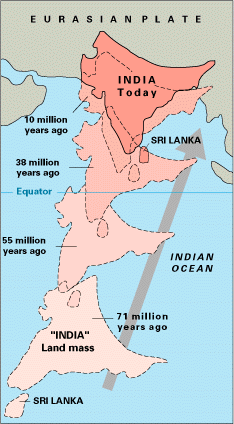
Northern Circars occupied the western coast of the Bay of Bengal and is now considered to be India's Madras state. The Kakatiya dynasty reached the western coastline of the Bay of Bengal between the Godavari and the Krishna rivers. Kushanas about the middle of the 1st century AD invaded northern India perhaps extending as far as the Bay of Bengal. Chola dynasty (9th century to 12th century) when ruled by Rajaraja Chola I occupied the western coastline of the Bay of Bengal circa AD 1014 Chandragupta Maurya extended the Maurya Dynasty across Northern India to the Bay of Bengal. Hajipur was a stronghold of Portuguese Pirates. In the 1500s the Portuguese built trading posts in the North of the Bay of Bengal at Chittagong (Porto Grande) and Satgaon (Porto Pequeno).
British penal colony
Cellular Jail or "Black Waters" built in 1896 on Ross Island, a part of the Andaman Island Chain. As early as 1858 this island was used as a British penal colony for politial prisoners facing life imprisonment.
Marine Archeology
Maritime archaeology or marine archaeology is the study of material remains of ancient peoples. A specialized branch, Archaeology of shipwrecks studies the salvaged artifacts of ancient ships. Stone anchors, amphorae sherds, elephant tusks, hippopotamus teeth, ceramic pottery, a rare wood mast and lead ingots are examples which may survive the test of time for archaeologists to study and place the salvaged findings into a time line of history. Coral reefs, tsuanamis, cyclones, mangrove swamps, battles and a criss cross of sea routes in a high trading area combined with pirating have all contributed to shipwrecks in the Bay of Bengal.
Famous ships and shipwrecks
- 1778 to 1783 The Naval operations in the American Revolutionary War or American War of Independence ranged as far as the Bay of Bengal.
- c1816 Mornington Ship burned in the Bay of Bengal
- 1850 American clipper brig Eagle is supposed to have sunk in a Bay of Bengal
- American Baptist missionary Adoniram Judson, Jr. died April 12, 1850 and was buried at sea in the Bay of Bengal.
- 1855 The Bark "Incredible" struck on a sunken rock in the Bay of Bengal
- 1865, a gale dismasted the Euterpe while traversing the Bay of Bengal typhoon.
- 1875 Veleda 76 m (250 ft) long and 15 m (50 ft) wide is a part of a current salvage operation.
- 1942 Japanese cruiser Yura of the Second Expeditionary Fleet, Malay Force attacked merchant ships in the Bay of Bengal.
- 1971 December 3 - It was claimed that Indian Navy destroyer INS Rajput sunk the Pakistan Navy submarine PNS Ghazi off of Vishakapatnam, in Bay Of Bengal List of naval battles
